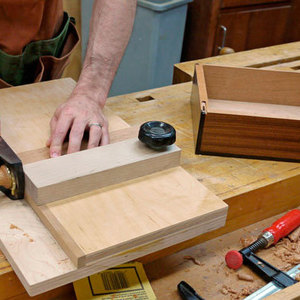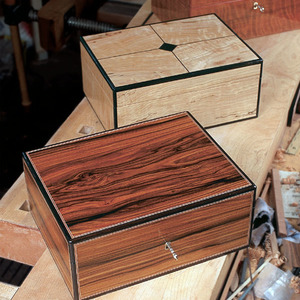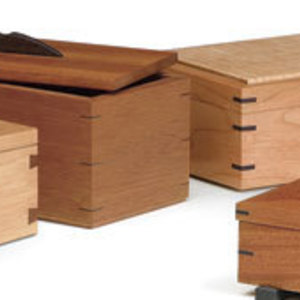Building a Humidor
Maintaining tropical humidity in a box takes precise joinery and Spanish cedar
A humidor that works is not just a nice box with a humidification device, though that’s often how they’re made, writes Rick Allyn. Maintaining 70% humidity is a balancing act that depends mostly on the wood you use and the tightness of the lid’s seal. Spanish cedar is the traditional wood choice for humidors, and Allyn explains why. Detailed project plans show how the front, back, and sided of the box are cut from one piece of veneered cedar and how the result is really a box inside a box. Allyn uses rabbets for edge-banding, which helps the box resist wear, and he explains how he bandsaws the box open and fits the hardware. The lining creates the seal, and he uses more Spanish cedar for that. Then he explains how to install the humidifier and finish the box. Side information presents a gallery of humidors of the finest craftsmanship and imagination.
You can smoke a dry cigar, but you won’t enjoy it. It will burn too hot, making the smoke acrid and unpleasant. Most of the flavor and all the subtleties of the tobacco will be lost. Cigars are made in the tropics where the relative humidity is a constant 70%, and they should be kept at that level. The relative humidity in Southern Idaho, where I live, is about 30% in the summer, and lower in the winter—a really hostile environment for cigars. I have had cigars dry up, even unwrap, four hours after I bought them.
A properly functioning humidor is a necessity for enjoying good cigars anywhere outside of the tropics. With only monthly upkeep, a well-made humidor will preserve cigars indefinitely. Very fine cigars even improve when aged in a humidor.
Building a humidor that works is not as simple as making a nice box and fitting a humidification device in it. This is often how they’re made, and the results are cigars ruined from too little or too much moisture. Maintaining 70% humidity is a balancing act that depends in large part on the wood you use and the tightness of the lid’s seal. It’s not rocket science, but making a good humidor takes some care in design and execution.
Why use Spanish cedar?
The wood you choose to make and line the humidor is particularly important. It Not just pretty boxes—Humidors need to be carefully constructed if they are to maintain the right humidity for cigars. should not have an unpleasant smell or taste because the cigars will pick it up. The wood also should be porous so it will first absorb, then release moisture evenly, while remaining dimensionally stable. The wood will reach 70% moisture content on the inside, while the humidity on the outside could be as low as 20%. For many woods, this is a recipe for severe cupping.
Spanish cedar is the traditional and best choice for a humidor. When kiln dried, it is very stable and will not warp or grow much when it reaches 70% moisture content. Its oils inhibit the growth of molds and mildew that destroy cigars. Spanish cedar has a delicate aroma that is complementary, enhancing the cigar’s taste.
From Fine Woodworking #127
For the full article, download the PDF below:
Fine Woodworking Recommended Products

Suizan Japanese Pull Saw





















Log in or create an account to post a comment.
Sign up Log in